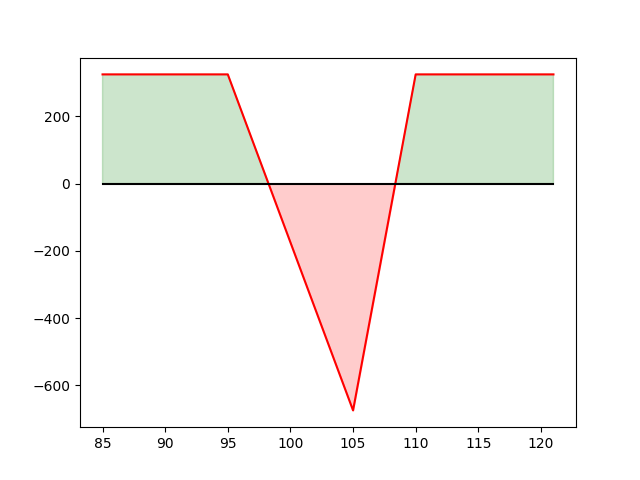A library to help calculate max loss, gain, net debit, credit, and break evens for various options strategies.
Build a Strategy by buying and selling Calls and Puts.
import profitnloss as pnl
# short christmas tree spread w/ calls
s = pnl.Strategy()
s.sell(pnl.Call(95, 8.4))
s.buy(pnl.Call(105, 2.35))
s.buy(pnl.Call(105, 2.35))
s.buy(pnl.Call(105, 2.35))
s.sell(pnl.Call(110, 0.95))
s.sell(pnl.Call(110, 0.95))
assert s.break_evens() == [98.25, 108.38]
assert s.max_gain() == 325
assert s.max_loss() == -675
assert s.net_cost() == -325
assert s.payoff(0) == 325
assert s.payoff(105) == -675
assert s.payoff(115) == 325
assert s.payoff(math.inf) == 325
print(s.break_evens())
print("max loss: %f, max gain: %f" % (s.max_loss(), s.max_gain()))
print("strikes and payoffs: " + str(list(zip(s.strikes(), s.payoffs(s.strikes())))))
s.plot()[98.25, 108.38]
max loss: -675.000000, max gain: 325.000000
strikes and payoffs: [(95.0, 325.0), (105.0, -675.0), (110.0, 325.0)]
One of the things curious about this design is that options contracts generally have 6 traits:
- Symbol of the underlying asset being tracked.
- Expiration date.
- Strike price (agreed upon future value of the underlying to potentially exercise the rights of the agreement at.)
- Type (Call or Put).
- Premium paid from buyer to seller.
- Whether the contract is being bought or sold.
You can calculate profit and loss diagrams for most strategies given everything but the first two. See the FAQ section at the bottom for more info.
For this library, the two contract classes (Call and Put) don't track
whether they're bought or sold, instead buying and selling are methods on a
Strategy class. The contract type is implied by the class, so constructing
an options contract with this library only involves explicitly supplying the
strike and premium.
A call option. Doesn't track a symbol. Doesn't track whether bought or sold; instead strategies do.
Call constructor, parameters:
strike:floatthe strike price in dollars.premium:floatthe value of the contract.num_shares:int(optional; default100) number of shares tracked.
Methods:
payoff returns the profit (if positive) or loss (if negative) of the contract
from the buyers perspective as a float, parameters:
spot:floatthe stock price at evaluation.
break_even returns the break even point of the contract as float.
A put option. Doesn't track a symbol. Doesn't track whether bought or sold; instead strategies do.
Put constructor, parameters:
strike:floatthe strike price in dollars.premium:floatthe value of the contract.num_shares:int(optional; default100) number of shares tracked.
Methods:
payoff returns the profit (if positive) or loss (if negative) of the contract
from the buyers perspective as a float, parameters:
spot:floatthe stock price at expiration.
break_even returns the break even point of the contract as float.
A set of purchased and sold Call and Put contracts.
Strategy constructor has no parameters.
Methods:
buy purchase a contract. No return value. Parameters:
contract: either aCallor aPut.
sell write a contract. No return value. Parameters:
contract: either aCallor aPut.
strikes: returns a sorted list of the unique strike prices (as floats) in
the Strategy. No parameters.
payoff_precise: returns the payoff at a given spot without any rounding
applied, so you can get interesting IEEE754 values for non-power-of-two (NPOT)
values. Useful when numerical precision is required, such as when calculating
roots. Note that the payoff is multiplied by the number of shares controlled.
Parameters:
spot:floatthe stock price at expiration.
payoff: retuns the payoff at a given spot rounded to two decimal places.
Parameters:
spot:floatthe stock price at expiration.
payoffs: returns a list of the payoffs for the given spots rounded to two
decimal places.
spots:[float]the stock prices at evaluation.
net_cost: returns the total credits minus debits from each contract's
premiums, multiplied by the number of shares per contract (default 100) then
rounded to two decimal places (as float). A net long position will have a
positive net_cost while a net short position will have a negative net_cost.
No parameters.
break_evens: returns the break even points of the strategy as a [float]
where each point has been rounded to two decimal places. No parameters.
max_loss: returns the largest possible deficit for the position as float
rounded to two decimal places. No Parameters.
max_gain: returns the largest possible profit for the position as float
rounded to two decimal places. No Parameters.
plot: a very simple method that uses matplotlib to plot the basic profit
and loss diagram. You can easily do better, using the above methods. No
parameters.
Apache 2.0
- Q: Why no horizontal ("calendar") or diagonal spreads?
- A: Because the break evens depend on implied volatility, which requires an underlying and exercise type. I'm working on that, but not for v1.
- Q: Is that a graph with unlabeled axes? And you call yourself an engineer!
- A: Plot it yourself then; I've given you the tools to do so here!
- Q: Did you name the library specifically for it to be
importedas pnl? Do you think you're funny?- A: Yes.
